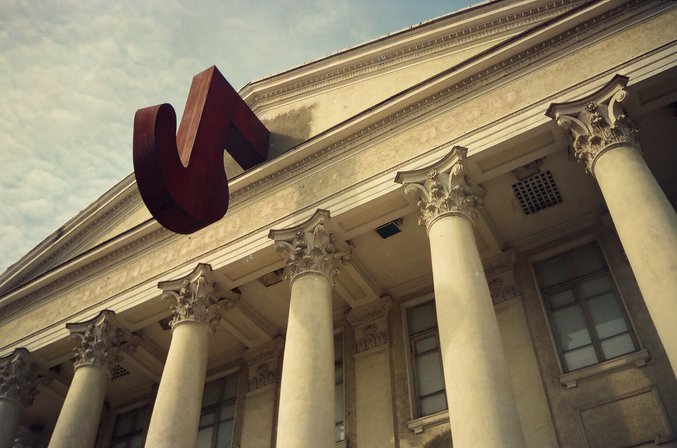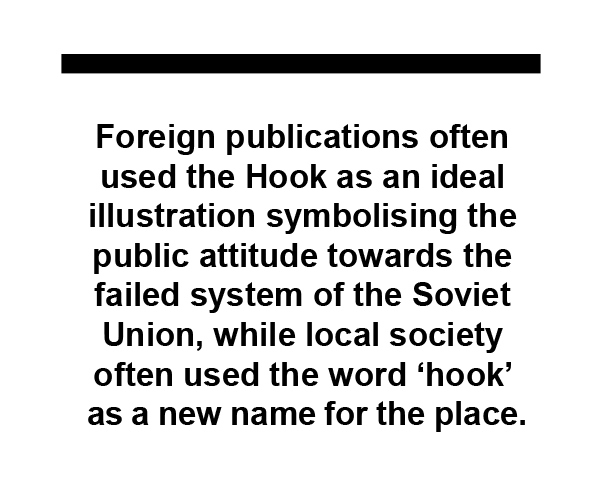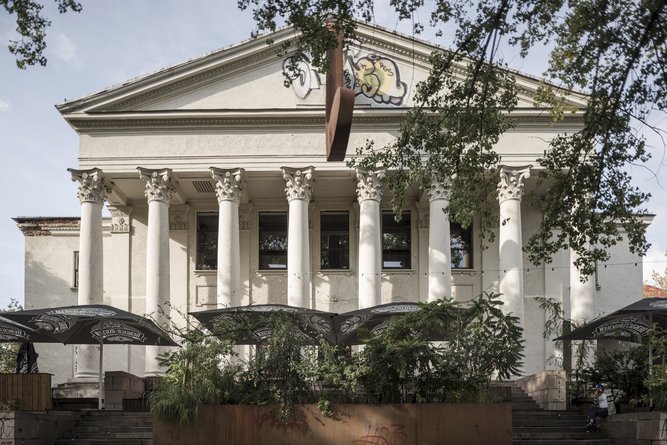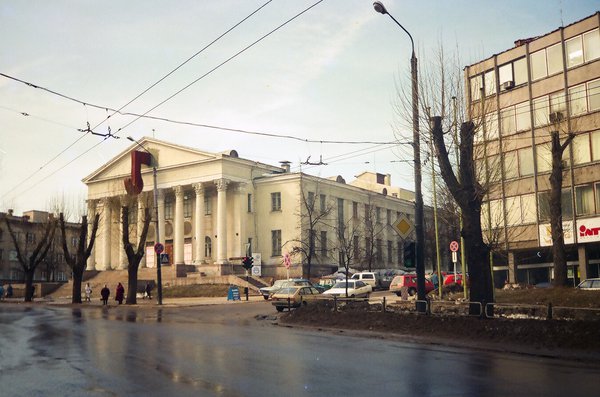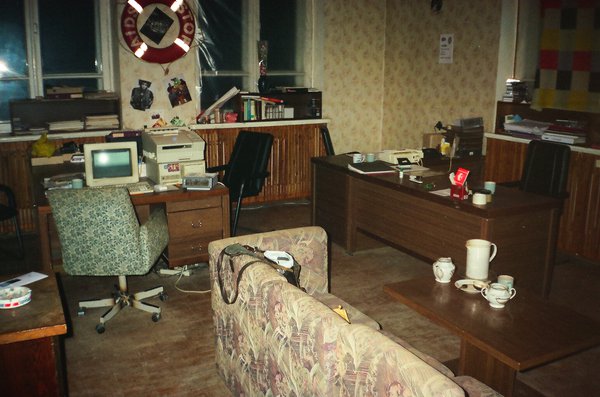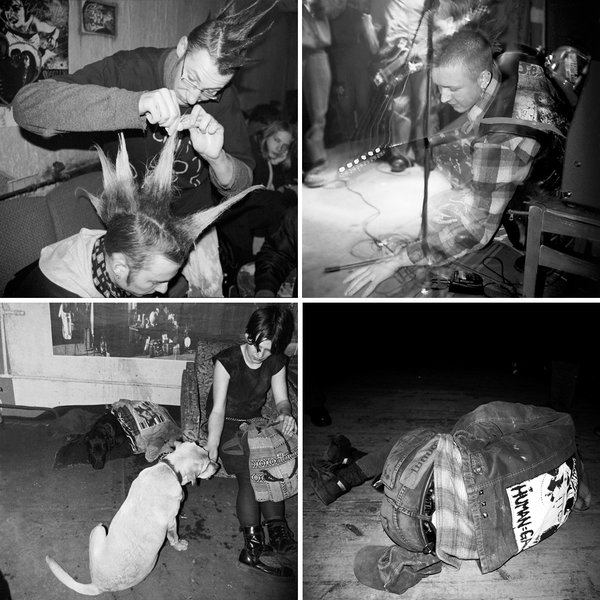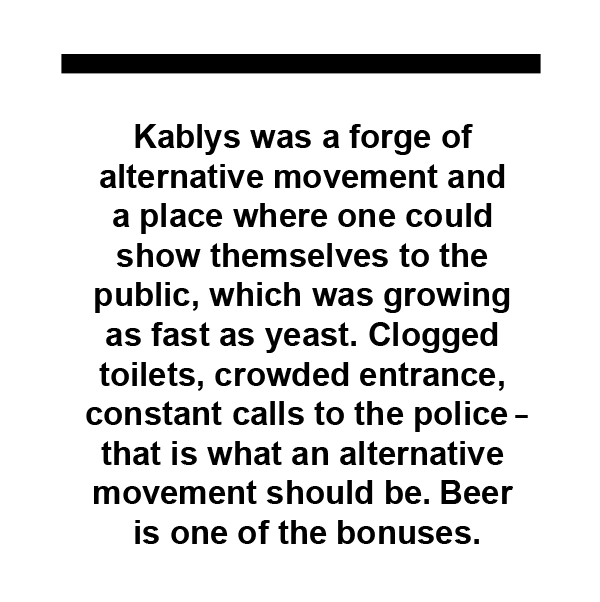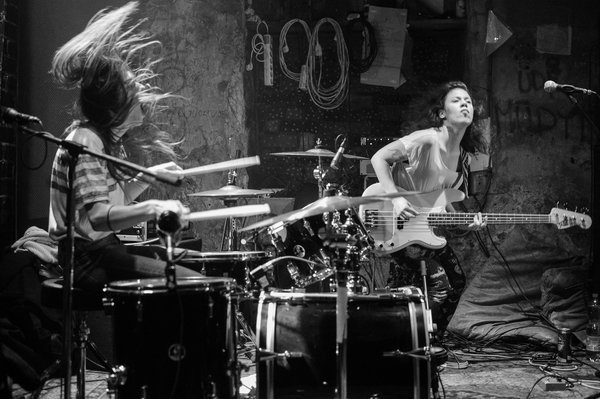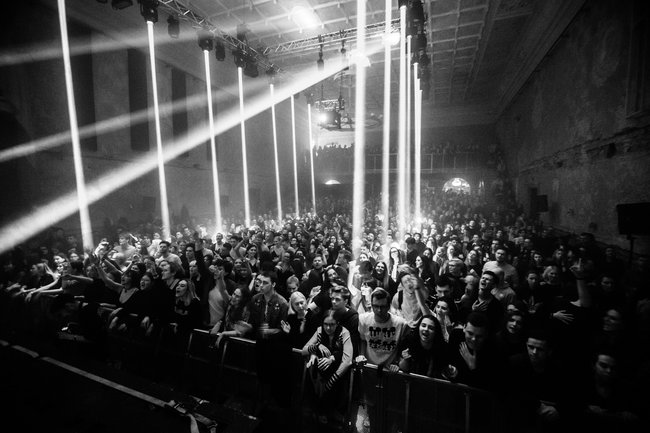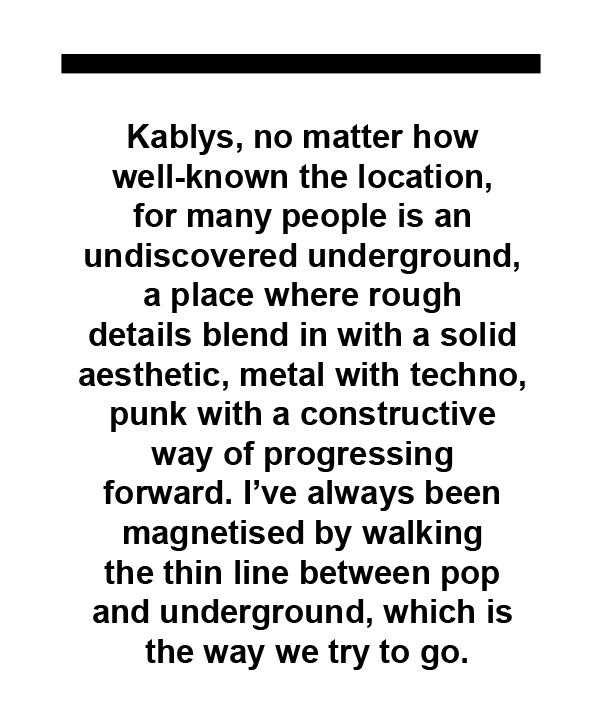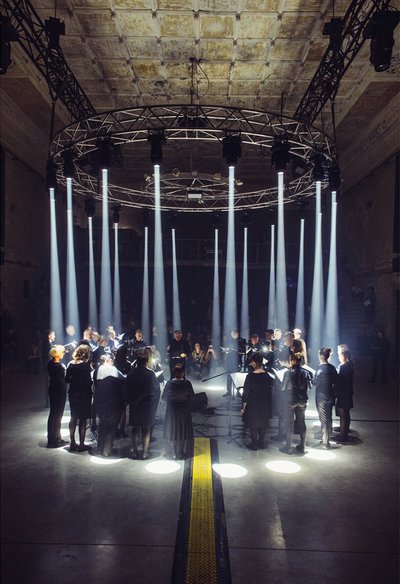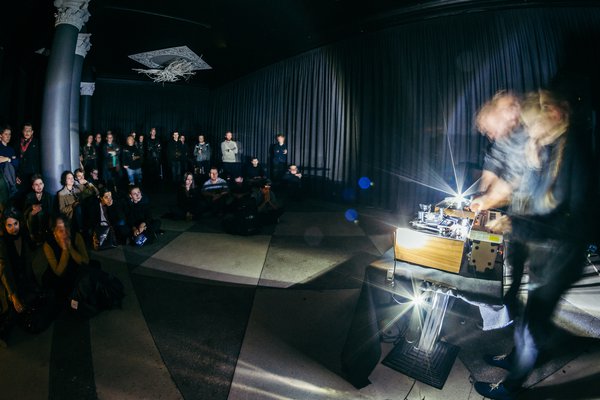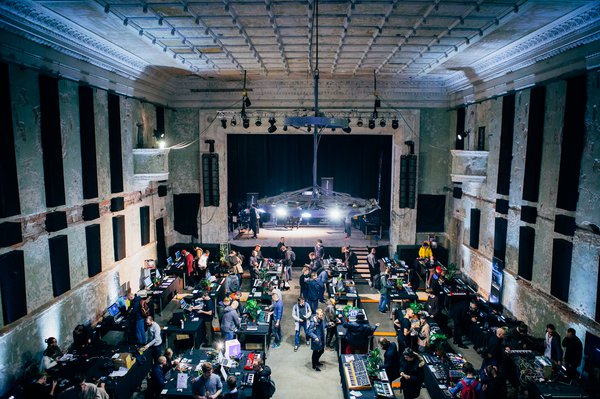Domininkas KUNČINAS | Kablys: Alternative Culture by Hook or by Crook
Spring 1993. I get off at the stop of trolleybus, one before Vilnius railway station. On the other side of the street stands a typical socialist building: a spacious staircase leads to an antique portico supported by eight massive columns. After crossing the cold, echoing lobby, I enter the great hall for the first time. An enormous chandelier overhead, frayed carpets, squeaking wooden chairs and a distinctive specific scent. The whiff of the past is still lingering here, but the sounds of the future are already heard from the stage, where the participants of the Festival of the Worst Bands are playing.
The Palace of Culture for Railway Workers was opened on the capital’s Kauno Street in 1956, with 3,200 square meters of usable and less so floor space. Walking through the building’s colonnade, visitors from Riga, Minsk, Kaliningrad or Moscow felt at home: similar ‘Soviet antique’ existed everywhere, differing only in its proportions and some other details.
At that time, there were few dance floors in Vilnius – the most popular places for ‘discos’ were the then Palace of Trade Unions and the Palace of Culture for Railway Workers. According to contemporaries, the former attracted a more intelligent crowd, as the area of the latter often demanded the demonstration of one’s ‘physical education,’ too. The neighbourhood around the station was famous for its harsh truth, and it can even be said that the building of the Palace of Culture for Railway Workers from the outset attracted a sort of ‘alternative’ layer of society that would settle in the palace cafe and disco until midnight. These Vilnius discos were talked about not only in the nearest cities but also in Kyiv, Leningrad and even Moscow. Gathering there was a multi-ethnic audience that was able to communicate in the must-have language for everyone, Russian, however dance was a much more universal means of communication. Quite often after an evening at the Palace of Culture for Railway Workers, local girls got married into other Soviet republics, whereas Vilnius guys brought home newcomer girls with exotic features.For several decades, the 500-seat hall hosted film screenings. They were watched here by Naujamiestis (New Town Neighbourhood) residents or travellers trying to kill some time until their train. Exhibitions of achievements of the Soviet collective farming and various leisure clubs were also organised in the Palace of Culture for Railway Workers.
Like the rest of the country, the Palace lived on five-year plans from Moscow and pursued an increasingly outdated programme. At the beginning of the 1986–1990 five-year period, Lithuania was still creating the ‘bright tomorrow’ of the USSR while by the end of it the country had already declared its independence. Even though the process was called the Singing Revolution, it was obvious that cultural affairs had been largely neglected in the time of such great changes. People were more concerned with where to get pasta and toilet paper. Taken over by the newly established Ministry of Culture and Education of the Republic of Lithuania, the building with darkened windows and disconnected heating system was waiting for better times.At the end of the year 1990, after a tour in the US, one of the most influential rock bands of the Lithuanian Independence movement, Antis, split up: The Mission: Independence was accomplished, and other work awaited. The band leader Algirdas Kaušpėdas became the head of the emerging Lithuanian television, while the rest of the band pursued various other interests. Petras Sniegius Ubartas, who played trumpet and guitar in the band, was looking for a space for his creative work and was offered to settle in the former House of Athletes located in the Old Town of Vilnius. At that time, an art gallery Langas was already active there and a café was opened soon.
The café started attracting gatherings by the local boheme: poets, painters, the cream of the city’s crop and... gangsters. For them, the entrance was free and there was always a table reserved – they usually ran up enormous bills for drinks. They did not understand rock or jazz but felt uplifted by being involved in cultural life. Once a saxophonist played live there, everyone liked it and so the idea of a club was born. In the autumn of 1992, the first Lithuanian music club Langas was opened in the hall of the same House of Athletes, and Petras Ubartas took up curating its cultural programme.
One summer day, after a ‘club night,’ Ubartas was sitting in the Langas yard with a pint of beer and a plate of herring with hot potatoes. By that time, Langas could no longer accommodate all the visitors, so Ubartas, having heard about the competition for ideas for the Palace of Culture for Railway Workers announced by the Ministry, wrote down his vision by hand the night before the deadline and gave it to be typed up. In 1993, Petras Ubartas became the director of the Palace. “The day I was appointed, I was thinking: I’m the director of this palace! I should go to the café and introduce myself. So, I’m sitting, looking around; the public is dreadful. Suddenly a few guys get up. come to sit at my table and, to add some weight to their argument, bam – place a gun on the table. But you can't be frightened, so I tell the bartender – give us all a drink! Suddenly one of them says, “I know you, you’re a cool dude, we once did a gig together.” It turns out we once played a concert as Antis and had invited many circus performers and acrobats. He was Valera ‘Cirkačius’ (‘The Circus Guy’), a graduate of the circus school in St. Petersburg. Unfortunately, his destiny played out in a rather peculiar way: he came back from his studies physically strong, hit someone in a restaurant, and that person turned out to be a KGB officer. And so Valera returned from prison already with a criminal record.”Under the auspices of not only the Minister of Culture and Education but also of local criminal structures, a public institution called Meno Lyga (Art League), a platform open to various alternative art projects, began to form in the former Palace of Culture for Railway Workers. The situation where an established and experienced artist helps others to make their first steps is familiar to many. For instance, in 1991, the first rock club alike those seen in the West, TaMtAm, was opened in St. Petersburg, Russia, by Vsevolod Gakel, a musician from the well-known band Akvarium. Those to whom other doors were closed could perform there. Petras Ubartas from Antis remembers the situation in the Lithuanian capital as follows: “I knew the condition of alternative youth subculture in Vilnius very well. They had absolutely no platform. In my case, it was pure patriotism. I realised the harm the state is inflicting upon itself by not helping to unleash the immense potential of young citizens of the country. There were many such people without a place who wanted to make art. Every era has such people. Today, too, there are people who are creating an alternative to what is already established. We received state funding and provided a maximally open space. All we had to do was spread the rumour that we had this space for them.” Upon hearing this, various young enthusiastic, ‘uncrushed’ people started to flock into it. The evolution of cultural processes began to be stimulated by processes happening on the grassroots level, which was new.
One of the first such grassroots projects was the non-profit, self-administered, interdisciplinary art programme Jutempus, founded by the world-renowned duo of artists Nomeda and Gediminas Urbonas and art historian Saulius Grigoravičius. Jutempus sought to investigate conflicts and contradictions caused by economic, social and ecological conditions in the post-Soviet period. This initiative was active in art, culture, education, ecology and technology fusions, working together with partner organisations and artists on projects to facilitate East-West and North-South links.
Having participated in international exhibitions, Gediminas Urbonas knew many artists and curators abroad. Even an international network of Jutempus patrons and collaborators called IPOJ was established in Helsinki that provided the organisation with publications and computers. Art historian Erika Grigoravičienė recalls: “By 1997, Jutempus had organised over 30 exhibitions of Lithuanian and foreign artists. Work by such artists as Svajonė and Paulius Stanikas, Akademinio pasiruošimo grupė (Academic Preparation Group), Džiugas Katinas, Mindaugas Navakas, Renata Valčik, Orūnė Morkūnaitė, Dainius Liškevičius and Žilvinas Kempinas (mainly installations adapted for the gallery’s space) were shown here. The biggest impression was made by art project Varymas (Distillation) by Jonas and Justinas Vaitiekūnas (1996) and Evaldas Jansas’ installation Meno morfologija (The Morphology of Art) presented the following year. As part of their project, the Vaitiekūnas brothers built a fully functioning moonshine distilling apparatus in the gallery (photographs of this type of equipment found in various dreary parts of the country were also on display). Evaldas Jansas housed there a pair of live pigs that broke their wooden stall at night, gnawed at other exhibits (a potted hemp plant and a tape recorder) and soiled the space horribly.”One art object still adorns the building’s facade and is its godfather of sorts. It is the work of the sculptor Mindaugas Navakas, winner of the Lithuanian National Prize for Culture and Arts. In 1994, the artist offered the new owner of the building a massive rusty... hook. It was supposed to be a temporary object, but it immediately provided the building with content and took such deep root that it has stayed here until now. The new artwork was hung in the place of the former emblem of the Lithuanian Soviet Socialist Republic. It was the first major sign of free creative thought. Immediately after the work was unveiled, it became the subject of discussion on art in public urban spaces and a symbol of change in post-Soviet territories. Foreign publications often used the Hook as an ideal illustration symbolising the public attitude towards the failed system of the Soviet Union, while local society often used the word ‘hook’ (Kablys in Lithuanian) as a new name for the place. Petras Ubartas remembers discussing with the sculptor what to do to prevent the sculpture’s enormous weight from pulling down the pediment of the building. “We made metal studs that we attached to the roof structures in the attic. But when the wind was stronger, I couldn’t sleep peacefully,” says the former head of the Art League with a smile.
It was only after the Kablys open policy on events became known that the area, at that time still waving a flag of dangerous criminality, began hosting the sounds of music. One of the first events was the already mentioned Festival of the Worst Bands, sponsored by the Open Society Foundation–Lithuania established by the famous philanthropist George Soros. The event featured some of the most progressive alternative musicians of the time, what could be called the first generation of Kablys. Most of their tracks were included in Zona Records’ 1996 collection entitled Kablys: Empti, Biplan, Blyškūs Veidai, Dogbones, Lemon Joy, Merlin, Sh.., Sexual Giant, Sumerland, and others. The legendary Lithuanian label Zona, which moved to Kablys from the Soviet apartment blocks in a sleeping district of Vilnius, also released other cassettes by young bands, sometimes referred to as ‘Kablys bands.’ At that time, the Zona office on the first floor with its 5-6 staff members was the only music distribution point in the Baltic States. Music lovers used to order production by 4AD, Factory, PIAS, Rough Trade, Warp, Ninja Tune and other indie and electronic music labels, interact with their peers and listen to music. The director of Zona Dovydas Bluvšteinas vividly remembers the times when they were freezing by gas heaters and condensation was flowing down the walls during bigger events. In his view, only the Palace of Trade Unions could compete with Kablys in the sense of alternative cultural heritage in Vilnius. Speaking of the Palace of Trade Unions, it is being demolished at present and there is a plan to build a National Concert Hall designed solely for the so-called high art in its place by 2023.Zona was also where the first DJs awaited vinyl records they had ordered. Many of them received their baptism of electronic dance music right there in the first-floor gallery. The open spaces of Kablys appealed even to the French DJ Bij, who came to Lithuania to work at the IKI supermarket chain. In 1994, DJs started organising here the first electronic music raves in Lithuania. Although the promotion of these events was minimal, the audience, thirsty for all things fresh, quickly tracked down where one could dance through the night. Another musician from Antis, Vytautas Kubilius, was often on duty for face control at the entrance to these raves. He remembers that at the dawn of rave culture, permission to organise events first had to be received… from gangsters. You come to Dainava restaurant, there is a table in a separate room, and sitting in silence at the end of it like the Godfather is the criminal world authority, Georgijus Dekanidze. He listens to young enthusiasts’ pitching their idea to organise contemporary dance raves. “Okay, let the guys do it. Good for us and good for them, too,” he finally utters.
The entire city crowd was attracted to the Fête de la Musique, flamboyant francophone events hosted in Kablys by the French cultural attaché. Those festivities spread from the lobby to the farthest nooks of the building – everything turned into a carnival of sorts. It was these events and the Strokes Temple rave initiated by DJ Saga in 1996 that became some of the highlights of the dawn of dance music in Lithuania. By the way, French cultural foundations were ready to finance Kablys activities if the Ministry of Culture of Lithuania would provide the funds for the ultimate renovation of the premises. Unfortunately, there was no cultural policy, let alone its unified strategy. According to Ubartas, it was not they who were ahead of time, but Lithuania was late. “I used to go and talk to those in power to make decisions. They were from the past and stayed in the past,” says the former head of the Art League. “We were modern people, people of our time. Everything should have happened, should have become engrained and now these things would have had a completely different dynamic, but there were many brakes...” The free stage of Kablys was used by other concert organisers as well. Some of the biggest heavy metal music events in the Baltic region, such as Death Comes festivals, and also solo concerts of various metal bands took place there.The original vision of Petras Ubartas and the Art League was to renovate and revitalise the entire massive building, but it had to be reduced to one hall on the first floor. Happening mostly through the efforts of volunteers, the process resulted in the club Geležinis Kablys (Iron Hook), which held regular events from 1996 to 1998. According to Vytautas Kubilius, about 10 enthusiasts installed everything – toilets, the bar, the club hall – with their own hands in 3 months. Kubilius was most impressed by the theatrical presentation of an album by the Lithuanian alternative rock band BIX, which featured the band leader singing while lying in a coffin, as well as DJ DNA from Dutch rap-rock band Urban Dance Squad and the gig by French rockers Jad Wio. Like Petras Ubartas, he found especially memorable the 1996 concert by Canadian punk/hardcore band NoMeansNo held in the great hall. People from Latvia, Belarus and Poland also came to this concert and one Canadian could not believe that a concert by his compatriots would actually take place here. While for the musicians themselves, Vilnius became memorable probably because of the attempt to rob their van and the smashed window.
It took several years for the next generation of Kablys to be born: The Balloons, dr.Green, Drigentai, Lėlės, Lipnūs Macharadžos Pirštai, Tai+ką?, Verslo rizikos rezervas, Zima and others. Former vocalist of Tai+ką? and current vocalist of the Baltic Balkan project Linas Lencas Starkus remembers: “Kablys was a forge of alternative movement and a place where one could show themselves to the public, which was growing as fast as yeast. Clogged toilets, crowded entrance, constant calls to the police – that is what an alternative movement should be. Beer is one of the bonuses.” Another bonus was the Starka bitter with apple juice. This cocktail was so popular that visitors of Kablys jokingly referred to themselves as starkatikiai (believers in Starka). In the cold season, this belief was simply vital as the building had not been heated for decades. Perhaps it was that all-permeating cold that also raised inexplicable anger. Vytautas Kubilius remembers that there was a lot of aggression around at that time that was expressed through destroying and sullying everything around. There was no shortage of clashes between the audience and the security guards, some of them almost ending tragically.From the Death Comes organiser Ugnius Liogė’s notes: “Audience is drunk and aggressive as never before. I don't know what happened, but it’s been a long time since I last saw so many drunken and cretinous mugs... Windows were smashed, fists were waved around, the sink in the toilet was crushed... At four o'clock, a horrendous huddle broke out at the entrance and unruly scoundrels fractured one of the Art League wall barriers and tried to break the side door. Some who forced themselves in were so drunk that they couldn’t comprehend they had to pay for the entrance and stared with glassy eyes, barely able to stand.”
The surrounding area of railway and bus stations was still a territory of elevated risk. The feeling of unsafety made many people refrain from going there. Only a few years ago, the perception of the city’s geography changed: initially, Kablys was far away, but now the alternative concert space Loftas located in the industrial area of Vilnius Naujamiestis (New Town) and even the Kirtimai Cultural Centre on the outskirts of Vilnius are considered to be close.
The Russian economic crisis of 1998 took with it many hopes and Kablys gradually started to die. However, in the same year, the ska-punk band dr.Green presented their debut album in the space beneath the big stage. The presentation was so successful that within the next five years the so-called Green club, functioning on the principles of DIY, influenced the emergence of similar venues in other cities of Lithuania: Kaunas, Klaipėda, Šiauliai, Šalčininkai and elsewhere. In addition to Lithuanian performers, underground bands from all over the world regularly performed here. There were several rehearsal rooms, a library of alternative literature, a Sunday vegan canteen, while the space of the current hostel on the first floor was occupied by squatters. At the same time, fanzine Kablys was launched – a publication about punk rock, hardcore and similar music scenes, featuring a variety of texts on music and more, and each issue was accompanied by a CD of current at that time music.In 2000, Kablys hosted a gig by the Canadian band Annihilator and Americans Overkill. A fire broke out during the concert. Firefighters had to evacuate nearly 2,000 metal music fans, well beyond squiffy, but nobody was hurt. According to the media at the time: “The abandoned building has no real owners and has not been renovated for several years. Recently, no events have been held here, only metal bands have performed sometimes.” But the underground Green Club held tumultuous concerts and parties until dawn for several more years. Such longevity was achieved through confidentiality – neither the posters nor the flyers contained the club’s address. At the end of 2003, a fire broke out again in Kablys; following that, not just the bands who used to rehearse here but the squatters, too, left the building.
For about five years, fenced up Kablys frightened passers-by with its falling plaster pieces until finally, in 2008, club XI20 opened its iron door in the basement, right next to the burnt down GreenClub, continuing the punk DIY tradition. Today the pulse of underground counterculture is best felt here, in what is called the “best hole of Vilnius.” Here, punk rock is understood in a broad sense, not only as a musical genre but also as an approach to creativity. Perhaps that is why this basement became loved by musicians of various styles, including experimental electronics and jazz. For example, in 2010 a vinyl record entitled Kablys: Live At 11:20 was released containing a recorded performance by jazz musicians Liudas Mockūnas, Eugenijus Kanevičius and Dalius Naujokaitis, which took place in this club.According to the media artist and art historian Vytautas Michelkevičius, the building was saved from destruction by the 2009-2010 economic crisis. He remembers collecting signatures to prevent the Palace from being replaced by a multi-storey office building. Fortunately, that did not happen, and the K.A.B.L.Y.S Active Leisure Centre with an indoor skateboard park was soon established here. The project did not take off, but it gave impetus to another life cycle of Kablys.
In 2013, the Kablys club was opened in the former lobby of the palace, directly below the former premises of the Geležinis Kablys club. At first, it was strange to dance in what used to be a cloakroom, but today it is hard to imagine it was ever different. The club programme curator Gytis Dubauskas, shares: “Everything has gone a long way beyond the promotional comfort zone. When choosing artists, I have formed three very economical criteria: relevance, renown, price. Kablys is not the place that buys overrated names and endows agencies in London or Berlin. Kablys, no matter how well-known the location, for many people is an undiscovered underground, a place where rough details blend in with a solid aesthetic, metal with techno, punk with a constructive way of progressing forward. When it comes to culture, it is constantly evolving, but I've always been magnetised by walking the thin line between pop and underground, which is the way we try to go. Education in club culture is a very difficult process, you just have to work and wait. It takes time for the individual, the event series, and the club itself to make a name. I’m not going to come up with a new formula, it just has to be a targeted work, sometimes simply hard labour.”
It looks like this strenuous work pays off – in the recent years the building on Kaunas str. 5 has become an important point on the maps and calendars of music lovers seeking unusual sounds in Vilnius. In the summertime, the stairs of Kablys turn into a terrace called Saulės Jėgainė (Solar Power Plant), while next to it there is a restaurant of the same name and a hostel has been opened in the space of the former squat on the first floor. The brewery Kuro Aparatūra (Fuel Machinery) has been developing its kraft beer recipes for more than a year. Skateboard ramps have been dismantled in the great hall and it has been revived as an events space. Some of the first to test it were the Lithuanian alternative rock band Abudu, Solo Ansamblis, in-depth exploring the interconnection between dark electronics and rock, and other artists. Kablys+Club is a dance nightclub offering harder rhythms and a harsher environment than their counterparts from the club Opium. Here you can expect such names as Cardopusher, Homemade Weapons, Mantra, SPFDJ, Years of Denial and other techno or drum'n'bass DJs, electrified beats or dark ambient artists. Meanwhile, Kablys+Culture is an open space for organisers of various events. Kablys has become a phenomenon which for several years now has had a summer embassy at the seaside and in 2019 hosted its first open-air festival, Cape Kablys.It is 2019. I am standing in the crowd in the very same Kablys and listening to the Australian experimental rock duo HTRK. Föllakzoid from Chile will soon be playing their kraut-techno trance here, events within the theatre festival Sirenos will be held, heavyweights from the USA Sunn O))) will be shaking the concrete of the great hall, the legendary Germans Tangerine Dream will be awakening cosmic spirits, electronic music gourmets will receive a treat in the form of the Canadian sound artist Tim Hecker, Lea Porcelain will echo Berlin postpunk, and the thundering of Aborted, Entombed A.D and Beast will remind audiences of the times of Death Comes. Traditional club events series like Hooked On, In Gloom, Knockturne, Souled Sessions should be added to that – and this is just a one-month agenda. There is also a restaurant, a hostel, a beer brewery and another club right on its doorstep. Could I have expected anything better when I came here for the first time 25 years ago?
Translated from the Lithuanian by Julija Gulbinovič
